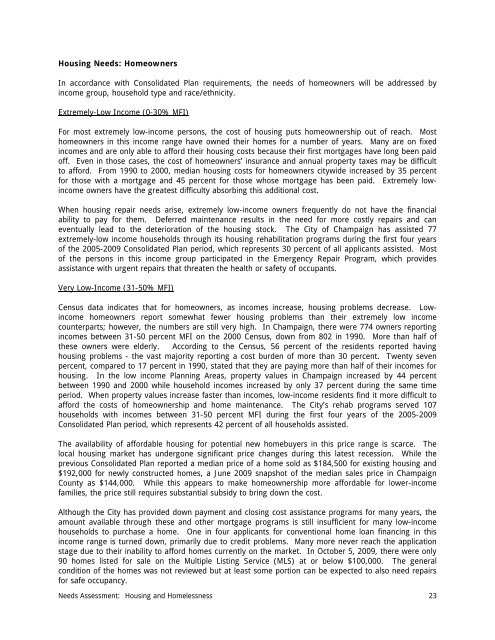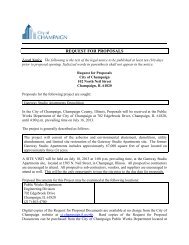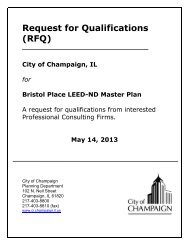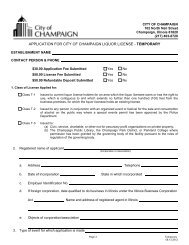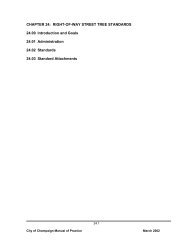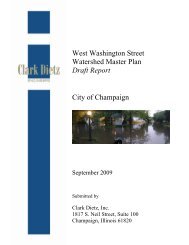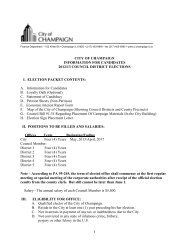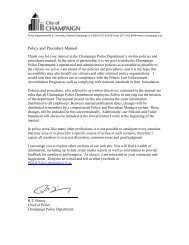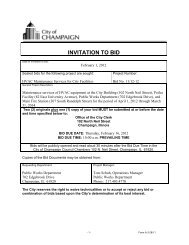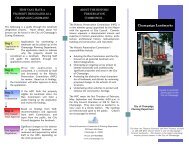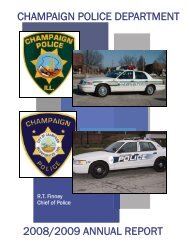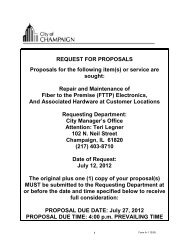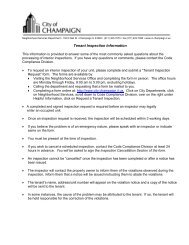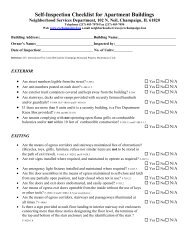2010-2014 Consolidated Plan - City of Champaign
2010-2014 Consolidated Plan - City of Champaign
2010-2014 Consolidated Plan - City of Champaign
You also want an ePaper? Increase the reach of your titles
YUMPU automatically turns print PDFs into web optimized ePapers that Google loves.
Housing Needs: HomeownersIn accordance with <strong>Consolidated</strong> <strong>Plan</strong> requirements, the needs <strong>of</strong> homeowners will be addressed byincome group, household type and race/ethnicity.Extremely-Low Income (0-30% MFI)For most extremely low-income persons, the cost <strong>of</strong> housing puts homeownership out <strong>of</strong> reach. Mosthomeowners in this income range have owned their homes for a number <strong>of</strong> years. Many are on fixedincomes and are only able to afford their housing costs because their first mortgages have long been paid<strong>of</strong>f. Even in those cases, the cost <strong>of</strong> homeowners’ insurance and annual property taxes may be difficultto afford. From 1990 to 2000, median housing costs for homeowners citywide increased by 35 percentfor those with a mortgage and 45 percent for those whose mortgage has been paid. Extremely lowincomeowners have the greatest difficulty absorbing this additional cost.When housing repair needs arise, extremely low-income owners frequently do not have the financialability to pay for them. Deferred maintenance results in the need for more costly repairs and caneventually lead to the deterioration <strong>of</strong> the housing stock. The <strong>City</strong> <strong>of</strong> <strong>Champaign</strong> has assisted 77extremely-low income households through its housing rehabilitation programs during the first four years<strong>of</strong> the 2005-2009 <strong>Consolidated</strong> <strong>Plan</strong> period, which represents 30 percent <strong>of</strong> all applicants assisted. Most<strong>of</strong> the persons in this income group participated in the Emergency Repair Program, which providesassistance with urgent repairs that threaten the health or safety <strong>of</strong> occupants.Very Low-Income (31-50% MFI)Census data indicates that for homeowners, as incomes increase, housing problems decrease. Lowincomehomeowners report somewhat fewer housing problems than their extremely low incomecounterparts; however, the numbers are still very high. In <strong>Champaign</strong>, there were 774 owners reportingincomes between 31-50 percent MFI on the 2000 Census, down from 802 in 1990. More than half <strong>of</strong>these owners were elderly. According to the Census, 56 percent <strong>of</strong> the residents reported havinghousing problems - the vast majority reporting a cost burden <strong>of</strong> more than 30 percent. Twenty sevenpercent, compared to 17 percent in 1990, stated that they are paying more than half <strong>of</strong> their incomes forhousing. In the low income <strong>Plan</strong>ning Areas, property values in <strong>Champaign</strong> increased by 44 percentbetween 1990 and 2000 while household incomes increased by only 37 percent during the same timeperiod. When property values increase faster than incomes, low-income residents find it more difficult toafford the costs <strong>of</strong> homeownership and home maintenance. The <strong>City</strong>’s rehab programs served 107households with incomes between 31-50 percent MFI during the first four years <strong>of</strong> the 2005-2009<strong>Consolidated</strong> <strong>Plan</strong> period, which represents 42 percent <strong>of</strong> all households assisted.The availability <strong>of</strong> affordable housing for potential new homebuyers in this price range is scarce. Thelocal housing market has undergone significant price changes during this latest recession. While theprevious <strong>Consolidated</strong> <strong>Plan</strong> reported a median price <strong>of</strong> a home sold as $184,500 for existing housing and$192,000 for newly constructed homes, a June 2009 snapshot <strong>of</strong> the median sales price in <strong>Champaign</strong>County as $144,000. While this appears to make homeownership more affordable for lower-incomefamilies, the price still requires substantial subsidy to bring down the cost.Although the <strong>City</strong> has provided down payment and closing cost assistance programs for many years, theamount available through these and other mortgage programs is still insufficient for many low-incomehouseholds to purchase a home. One in four applicants for conventional home loan financing in thisincome range is turned down, primarily due to credit problems. Many more never reach the applicationstage due to their inability to afford homes currently on the market. In October 5, 2009, there were only90 homes listed for sale on the Multiple Listing Service (MLS) at or below $100,000. The generalcondition <strong>of</strong> the homes was not reviewed but at least some portion can be expected to also need repairsfor safe occupancy.Needs Assessment: Housing and Homelessness 23


